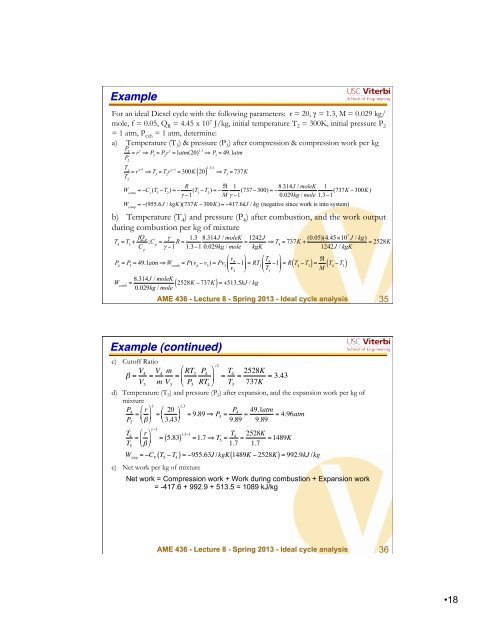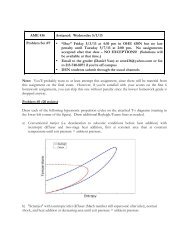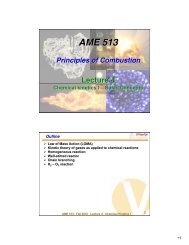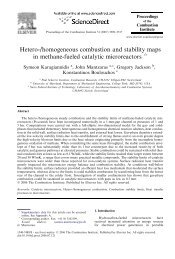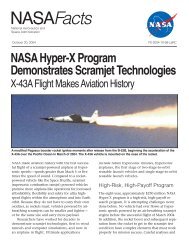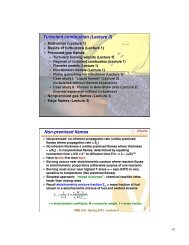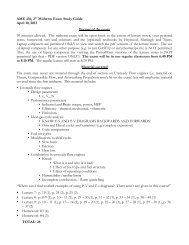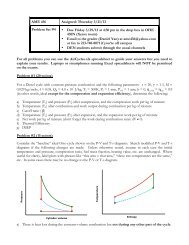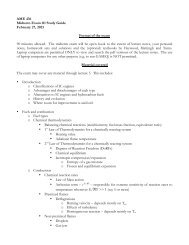AME 436
AME 436
AME 436
Create successful ePaper yourself
Turn your PDF publications into a flip-book with our unique Google optimized e-Paper software.
Example"<br />
For an ideal Diesel cycle with the following parameters: r = 20, γ = 1.3, M = 0.029 kg/<br />
mole, f = 0.05, Q R = 4.45 x 10 7 J/kg, initial temperature T 2 = 300K, initial pressure P 2<br />
= 1 atm, P exh = 1 atm, determine:<br />
a) Temperature (T 3 ) & pressure (P 3 ) after compression & compression work per kg<br />
P 3<br />
P 2<br />
= r ! ! P 3<br />
= P 2<br />
r ! =1atm(20) 1.3 ! P 3<br />
= 49.1atm<br />
T 3<br />
= r !"1 ! T<br />
T<br />
3<br />
= T 2<br />
r !"1 = 300K ( 20) 1.3"1 ! T 3<br />
= 737K<br />
2<br />
W comp<br />
= "C v<br />
(T 3<br />
"T 2<br />
) = " R<br />
! "1 (T "T ) = " # 1<br />
8.314J / moleK 1<br />
(737 " 300) = " (737K " 300K)<br />
3 2<br />
M ! "1 0.029kg / mole 1.3"1<br />
W comp<br />
= "(955.6J / kgK)(737K " 300K) = "417.6kJ / kg (negative since work is into system)<br />
b) Temperature (T 4 ) and pressure (P 4 ) after combustion, and the work output<br />
during combustion per kg of mixture<br />
T 4<br />
= T 3<br />
+ fQ R<br />
;C<br />
C<br />
p<br />
= !<br />
p<br />
! !1 R = 1.3 8.314J / moleK<br />
1.3!1 0.029kg / mole = 1242J<br />
kgK<br />
$ v '<br />
P 4<br />
= P 3<br />
= 49.1atm " W comb<br />
= P(v 4<br />
! v 3<br />
) = Pv 4<br />
3 & !1<br />
% v<br />
)<br />
3 (<br />
= RT $ T '<br />
4<br />
!1<br />
3&<br />
% T<br />
)<br />
3 (<br />
= R T !T 4 3<br />
W comb<br />
=<br />
8.314J / moleK<br />
0.029kg / mole<br />
( 2528K ! 737K) = +513.5kJ / kg<br />
" T = 737K + (0.05)(4.45#107 J / kg)<br />
= 2528K<br />
4<br />
1242J / kgK<br />
( ) = * (<br />
M T !T 4 3)<br />
<strong>AME</strong> <strong>436</strong> - Lecture 8 - Spring 2013 - Ideal cycle analysis<br />
35<br />
!<br />
!<br />
Example (continued)"<br />
c) Cutoff Ratio<br />
" = V 4<br />
= V 4<br />
m<br />
= RT )1<br />
#<br />
3<br />
P 4<br />
&<br />
% ( = T 4<br />
= 2528K<br />
V 3<br />
m V 3 $ P 3<br />
RT 4 ' T 3<br />
737K = 3.43<br />
d) Temperature (T 5 ) and pressure (P 5 ) after expansion, and the expansion work per kg of<br />
mixture<br />
P 4<br />
= r )<br />
# & #<br />
% ( = 20 &<br />
1.3<br />
% ( = 9.89 * P<br />
P 5 $ " ' $ 3.43'<br />
5<br />
= P 4<br />
9.89 = 49.1atm = 4.96atm<br />
9.89<br />
T 4<br />
#<br />
= r &<br />
% (<br />
T 5 $ " '<br />
) +1<br />
W exp<br />
= +C V<br />
T 5<br />
+ T 4<br />
= ( 5.83) 1.3+1 =1.7 * T 5<br />
= T 4<br />
1.7 = 2528K =1489K<br />
1.7<br />
( ) = +955.63J /kgK( 1489K + 2528K) = 992.9kJ /kg<br />
e) Net work per kg of mixture<br />
Net work = Compression work + Work during combustion + Expansion work<br />
= -417.6 + 992.9 + 513.5 = 1089 kJ/kg<br />
<strong>AME</strong> <strong>436</strong> - Lecture 8 - Spring 2013 - Ideal cycle analysis<br />
36<br />
• 18


